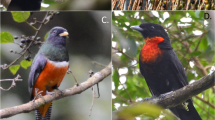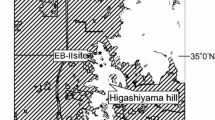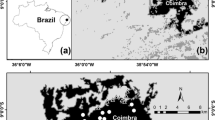Abstract
This chapter considers the ways phenological cycles of resource production interact with frugivore communities in tropical forests. The birds and mammals that feed primarily on plant reproductive parts (seeds and pulp) at an undisturbed Amazonian locality in southeastern Peru make up a biomass of about 1,400 kg/km2 of mammals and 160 kg/km2 of birds. In order of importance, the major groups of mammals are primates, rodents and peccaries, and of birds, are cracids, tinamous and toucans. About a third of the total biomass consists of seed predators which feed mostly on the ground and two thirds of pulp eaters which feed mainly in trees.
The production of fruits and seeds by the forest at this site follows a two-peaked annual cycle of high amplitude. During the low point in this cycle, a 3–4 month period covering the transition from wet to dry seasons, the production of plant reproductive parts falls below the estimated consumption rate of the frugivore community. In response, many animals modify their diets by switching to a limited number of alternate food resources. In all, only 12 plant species, here termed ‘keystone plant resources’, sustain as much as 80% of the animal biomass through the annual period of scarcity. The abundance of these keystone resources appears to set the carrying capacity of the forest for frugivorous animals, and in turn, many of these frugivores appear to possess adaptations for harvesting particular keystone resources.
At the end I review the available information on phenological patterns of fruit production in tropical forests around the world in an effort to extend the generality of these results to other areas of the tropics.
Access this chapter
Tax calculation will be finalised at checkout
Purchases are for personal use only
Preview
Unable to display preview. Download preview PDF.
Similar content being viewed by others
Literature cited
Charles-Dominique, P. 1977. Ecology and Behavior of Nocturnal Primates: Prosimians of Equatorial West Africa. Columbia Univ. Press, N.Y.
Chivers, D.J. 1973. An introduction to the socio-ecology of Malayan forest primates. In: Comparative Ecology and Behavior of Primates, (eds. R.B. Michael & J.H. Crook), pp. 101–146. Academic Press, London.
Clutton-Brock, T.H. and P.H. Harvey. 1977. Species differences in feeding and ranging behavior in primates. In: Primate Ecology: Studies of Feeding and Ranging Behaviour in Lemurs, Monkeys and Apes (ed. T.H. Clutton-Brock), pp. 539–556. Academic Press, London.
Croat, T.B. 1975. Phenological behavior of habit and habitat classes on Barro Colorado Island (Panama Canal Zone). Biotropica 7: 270–277.
Crome, F.H.J. 1975. The ecology of fruit pigeons in tropical northern Queensland. Aust. Wildl. Res. 2: 155–185.
Emmons, L.H. 1984. Geographic variation in densities and diversities of non-flying mammals in Amazonia. Biotropica 16: 210–222.
Eisenberg, J.F. and R.W. Thorington. 1973. A preliminary analysis of a Neotropical mammal fauna. Biotropica 5: 150–161.
Fogden, M.P.L. 1972. The seasonality and population dynamics of equatorial forest birds in Sarawak. Ibis 114: 307–343.
Foster, R.B. 1973. Seasonality of Fruit Production and Seed Fall in a Tropical Forest Ecosystem in Panama. Ph.D. dissertation, Duke University, Durhan, North Carolina.
Foster, R.B. 1982a. The seasonal rhythm of fruitfall on Barro Colorado Island. In: The Ecology of a Tropical Forest: Seasonal Rhythms and Long-term Changes (eds. E.G. Leigh, Jr., A.S. Rand and D.M. Windsor), pp. 151–172. Smithsonian Inst. Press, Washington, D.C.
Foster, R.B. 1982b. Famine on Barro Colorado Island. In: The Ecology of a Tropical Forest: Seasonal Rhythms and Longterm Changes (eds. E.G. Leigh, Jr., A.S. Rand and D.M. Windsor), pp. 210–212. Smithsonian Inst. Press, Washington, D.C.
Frankie, G.W., H.G. Baker and P.A. Opler. 1974. Comparative phenological studies of trees in tropical wet and dry forests in the lowlands of Costa Rica. Journ. Ecol. 62: 881–919.
Gautier-Hion, A., J-M. Duplantier, R. Quris, F. Feer, C. Sourd, J.P. Decoux, G. Dubost, L. Emmons, C. Erard, P. Hecketsweiler, A. Moungazi, C. Roussilhon and J.M. Thiollay. 1985. Fruit characters as a basis of fruit choice and seed dispersal in a tropical forest vertebrate community. Oecologia 65: 324–337.
Gautier-Hion, A., J-M. Duplantier, L. Emmons, F. Feer, P. Hecketsweiler, A. Moungazi, R. Quris and C. Sourd. 1985. Coadaptation entre rythmes de fructification et frugivorie en foret tropicale humide du Gabon: mythe ou realite. Rev. Ecol. (Terre et Vie) 40: 405–429.
Glanz, W.E. 1982. The terrestrial mammal fauna of Barro Colorado Island: census and long-term changes. In: The Ecology of a Tropical Forest: Seasonal Rhythms and Long-term Changes (eds. E.G. Leigh, Jr., A.S. Rand and D.M. Windsor), pp. 455–468. Smithsonian Inst. Press, Washington, D.C.
Hladik, C.M. 1975. Ecology, diet, and social patterning in Old and New World primates. In: Socioecology and Psychology of Primates (ed. R. Tuttle), pp. 3–35. World Anthropology. Mouton, The Hague.
Hladik, C.M. 1979. Diet and ecology of prosimians. In: The Study of Prosimian Behavior (eds. G.A. Doyle and R.D. Martin), pp. 307–357. Academic Press, N.Y.
Hladik, C.M., P. Charles-Dominique and J.J. Petter. 1980. Feeding strategies of five nocturnal prosimians in the dry forest of the west coast of Madagascar. In: Nocturnal Malagasy Primates: Ecology, Physiology, and Behavior, pp. 41–73. Academic Press, N.Y.
Hladik, C.M. and A. Hladik. 1972. Disponibilites alimentaires et domaines vitaux des primates à Ceylon. Terre et Vie 26: 149–215.
Howe, H.F. 1977. Bird activity and seed dispersal of a tropical wet forest tree. Ecology 58: 539–550.
Howe, H.F. 1980. Monkey dispersal and waste of a Neotropical fruit. Ecology 61: 944–959.
Howe, H.F. 1982. Fruit production and animal activity in two tropical trees. In: The Ecology of a Tropical Forest: Seasonal Rhythms and Long-term Changes (eds. E.G. Leigh, Jr., A.S. Rand and D.M. Windsor), pp. 189–199. Smithsonian Inst. Press, Washington, D.C.
Janson, C.H. 1983. Adaptation of fruit morphology to dispersal agents in a neotropical rainforest. Science 219: 187–189.
Janson, C.H., J. Terborgh and L.H. Emmons. 1981. Non-flying mammals as pollinating agents in the Amazonian forest. Biotropica, Suppl. 1–6.
Janzen, D.H. 1974. Tropical blackwater rivers, animals, and mast fruiting by the Dipterocarpaceae. Biotropica 6: 69–103.
Kiltie, R. A. 1982. Bite force as a basis for niche differentiation between rain forest peccaries (Tayassu tajacu and T. pecari). Biotropica 14: 188–195.
Kiltie, R.A. and J. Terborgh. 1983. Observations of the behavior of rain forest peccaries in Peru: why do white-lipped peccaries form herds? Zeitschr. Tierpsychol. 62: 241–255.
Kinzey, W.G. 1974. Ceboid models for the evolution of hominoid dentition. Journ. Human Evolution 3: 193–203.
Leigh, E.G., Jr. and N. Smythe. 1978. Leaf production, leaf consumption, and the regulation of folivory on Barro Colorado Island. In: The Ecology of Arboreal Folivores (ed. G.G. Montgomery), pp. 51–73. Smithsonian Inst. Press, Washington, D.C.
Leighton, M. and D.R. Leighton. 1983. Vertebrate responses to fruiting seasonality within a Bornean rain forest. In: Tropical Rain Forest: Ecology and Management (eds. S.L. Sutton, T.C. Whitmore and A.C. Chadwick), pp. 181–196. Blackwell Sci. Publ., London.
McClure, H.E. 1964. Flowering, fruiting and animals in the canopy of a tropical rain forest. Malay. Forester 29: 182–203.
Medway, L. 1972. Phenology of a tropical rain forest in Malaya. Biol. Journ. Linnean Soc. 4: 117–146.
Milton, K. and M.L. May. 1976. Body weight, diet and home range area in primates. Nature 259: 459–462.
Mittermeier, R.A. and M.G.M. van Roosmalen. 1981. Preliminary observations on habitat utilization and diet in eight Surinam monkeys. Folia Primatol. 36: 1–39.
Nagy, K.A. and K. Milton. 1979. Energy metabolism and food consumption by wild howler monkeys (Alouatta palliata). Ecology 60: 475–480.
Ng, F.S.P. 1981. Vegetative and reproductive phenology of dipterocarps. Malay. Forester 44: 197–221.
Peters, R.H. 1983. The Ecological Implications of Body Size. Cambridge, Univ, Press, Cambridge.
Raemaekers, J.J., F.P.G. Aldrich-Blake and J.B. Payne. 1980. The forest. In: Malayan Forest Primates (ed. D.J. Chivers), pp. 29–61. Plenum, New York.
Rodman, P.S. 1978. Diets, densities, and distributions of Bornean primates. In: The Ecology of Arboreal Folivores (ed. G.G. Montgomery), pp. 465–478. Smithsonian Inst. Press, Washington, D.C.
Schaik, C.P. van and Noordwyk, M.A. van. 1985. Interannual variability in fruit abundance and the reproductive seasonality of Sumatran long-tailed macaques (Macaca fascicularis). Journ. Zool. (Lond.) 206: 533–
Smythe, N. 1970. Neotropical fruiting seasons and fruit dispersal. Amer. Natur. 104: 25–35.
Smythe, N., W.E. Glanz and E.G. Leigh, Jr. 1982. A.S. Rand and D.M. Windsor), pp. 227–238. Smithsonian Inst. Press, Washington
Snow, D.W. 1971. Evolutionary aspects of fruit-eating by birds. Ibis 113: 194–202.
Snow, D.W. 1981. Tropical frugivorous birds and their food plants: a world survey. Biotropica 13: 1–14.
Stanley, S. 1979. Macroevolution: Pattern and Process.
Struhsaker, T.T. and L. Leland. 1979. Socio-ecology of five sympatric monkey species in the Kibale Forest, Uganda. Adv. Stud. Behav. 9: 159–227.
Stiles, E.W. 1980. Patterns of fruit presentation and seed dispersal in bird-disseminated woody plants in the eastern deciduous forest. Amer. Natur. 116: 670–688.
Szalay, F. and E. Delson. 1979. Evolutionary History of the Primates. Academic Press, N.Y.
Terborgh, J. 1983. Five New World Primates. Princeton Univ. Press, Princeton, N.J.
Terborgh, J. 1985. Habitat selection in Amazonian birds. In: Habitat Selection in Birds (ed. M.L. Cody), pp. 311–338. Academic Press, N.Y.
Terborgh, J. 1986. Keystone plant resources in the tropical forest. In: Conservation Biology II (ed. M.E. Soule), pp. (in press).
Terborgh, J., J.W. Fitzpatrick and L.H. Emmons. 1983. An annotated list of the birds and mammals of Cocha Cashu Biological Station. Fieldiana. (New Ser.) 21: 1–29.
Walter, H. 1973. Vegetation of the Earth in Relation to Climate and the Eco-physiological Conditions. Springer Verlag, N.Y.
Wheelwright, N.T. and G.H. Orians. 1982. Seed dispersal by animals: contrasts with pollen dispersal, problems of terminology, and constraints on coevolution. Amer. Natur. 119: 402–413.
Willis, E.O. 1966. Competitive exclusion and birds at fruiting trees in western Colombia. Auk 83: 479–480.
Author information
Authors and Affiliations
Editor information
Rights and permissions
Copyright information
© 1986 Dr W. Junk Publishers, Dordrecht
About this chapter
Cite this chapter
Terborgh, J. (1986). Community aspects of frugivory in tropical forests. In: Estrada, A., Fleming, T.H. (eds) Frugivores and seed dispersal. Tasks for vegetation science, vol 15. Springer, Dordrecht. https://doi.org/10.1007/978-94-009-4812-9_32
Download citation
DOI: https://doi.org/10.1007/978-94-009-4812-9_32
Publisher Name: Springer, Dordrecht
Print ISBN: 978-94-010-8633-2
Online ISBN: 978-94-009-4812-9
eBook Packages: Springer Book Archive




